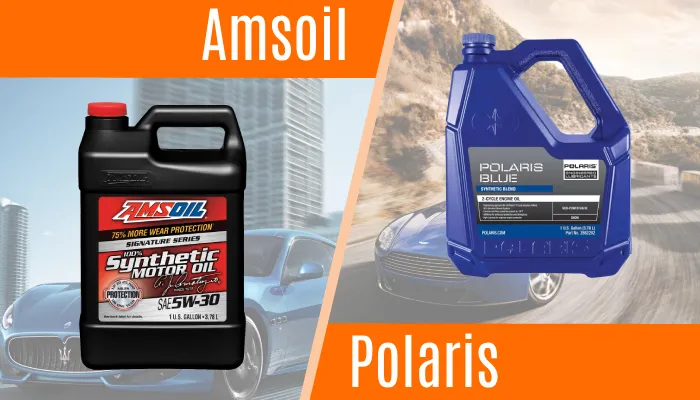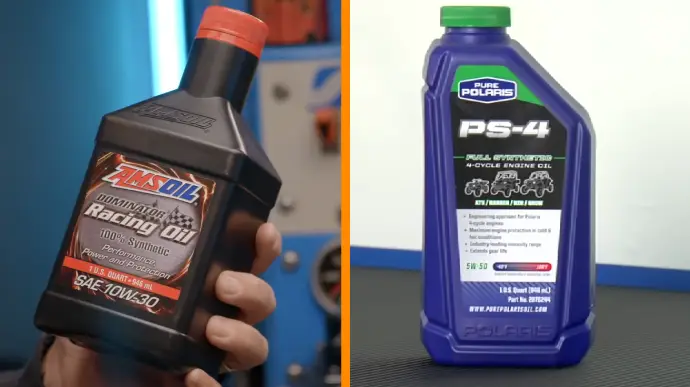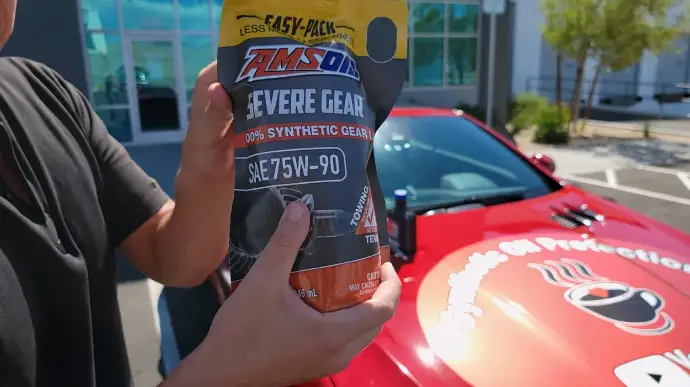Physical Address
304 North Cardinal St.
Dorchester Center, MA 02124
Physical Address
304 North Cardinal St.
Dorchester Center, MA 02124

For maintaining the longevity and performance of your vehicle, choosing the right oil is paramount. Two popular options in the world of vehicle lubricants are Amsoil and Polaris oil, each with its own set of advantages and drawbacks.
Amsoil provides robust protection against rust and corrosion, making it an ideal choice for vehicles exposed to harsh conditions. Additionally, Amsoil is known for its advanced additive packages, offering engine performance enhancements such as improved fuel efficiency and cleaner engines.
In contrast, Polaris oil offers less effective rust protection and a more basic additive package. It potentially leads to a shorter service life and reduced engine optimization.
Here, we’ll break down the differences between Amsoil and Polaris oil, so you can choose one wisely. We’ll cover everything from where Amsoil oil comes from to whether you have to use Polaris oil.
No products found.

Let’s break down the differences between these two oil types to help make your decision easier.
To maximize the longevity of your vehicle, prioritize robust rust and corrosion protection when choosing between Amsoil and Polaris oil.
Amsoil excels in this aspect, providing long-lasting protection against rust and corrosion. A strong barrier prevents moisture and environmental elements from damaging it. This is especially useful in challenging environments, such as off-road or in regions with extreme weather conditions.
Conversely, Polaris oil falls short in rust and corrosion protection, making it less suitable for extended exposure to harsh conditions. Their oils don’t contain the same protective elements as Amsoil.
Amsoil typically offers a broader viscosity range, allowing it to maintain its lubricating properties in both cold and hot conditions. This versatility makes it suitable for vehicles operating in diverse climate conditions.
On the other hand, Polaris oil may have a more limited viscosity range, making it less adaptable to extreme temperature variations. This could potentially lead to issues with lubrication and performance in extreme temperatures.
When choosing between Amsoil and Polaris oil for your vehicle, it’s important to consider the suitability of the engines and components you have.
Amsoil is specifically designed for engines with stainless steel components, providing superior protection and lubrication for these parts.
Alternatively, Polaris Oil offers a wider range of options based on engine specifications, a benefit if your vehicle has a variety of components. By offering different formulations, Polaris oil caters to various engine types and ensures optimal performance and longevity.
Amsoil stands out with its advanced additive packages, designed to enhance engine performance and provide additional benefits. These packages can improve fuel efficiency and promote cleaner engines, going beyond basic lubrication.
On the other hand, Polaris oil may have a more basic additive package, lacking the same level of performance enhancements. Therefore, if you’re looking for an oil that lubricates and optimizes your engine, Amsoil is the more attractive option.
Amsoil is known for its compatibility with aftermarket modifications, making it a popular choice among vehicle owners with customized engines. Amsoil is specially engineered in modified vehicles to resist viscosity loss due to mechanical shear.
This means that even with added accessories or engine modifications, Amsoil remains viscous and provides the necessary lubrication.
Alternatively, Polaris oil mightn’t offer the same level of compatibility with aftermarket modifications. Using Polaris oil in a modified vehicle could lead to performance issues and inadequate engine protection.
Therefore, choosing Amsoil is a critical advantage if you’ve customized your vehicle.
AMSOIL Synthetic ATV/UTV Powertrain Fluid is a direct replacement for POLARIS Demand Drive Fluid and POLARIS AGL Synthetic Gearcase Lubricant and Transmission Fluid. This eliminates the need to purchase and store multiple OEM lubricants, making maintenance easier and more streamlined.
In contrast, Polaris oil doesn’t offer the same convenience since it must be used separately for each lubrication job. You may need to purchase additional Polaris lubricants if you have made aftermarket modifications to your vehicle. This is less convenient and potentially leads to mistakes in oil selection.
Regarding the convenience of packs and reduced mess, Amsoil outshines Polaris oil for your vehicle.
Amsoil offers easy-to-use packs that simplify the oil change process and minimize the risk of spills and leaks. These convenient packaging options make handling and pouring the oil easier, reducing the chances of making a mess during lubricant installations.
On the other hand, Polaris oil comes in less user-friendly containers, making oil changes a messier and more challenging task. The risk of spills and leaks is higher with Polaris oil, potentially leading to a messier work environment and added cleanup time.
Amsoil’s advanced formulation offers an extended service life of up to 25000 miles. This is thanks to its high-quality base oils and additives that protect against wear, deposits, and oxidation.
Amsoil’s superior formulation allows the oil to maintain its viscosity and lubricating properties for an extended period. This reduces the need for frequent oil changes and helps to reduce maintenance.
However, Polaris oil may require frequent changes to maintain optimal protection and performance. Although still effective, regular oil changes are essential to prevent contaminants from building up and causing engine damage.
Choosing between Amsoil and Polaris oil can make a significant difference in reducing your vehicle’s environmental impact.
Amsoil’s formulations have been designed to be more eco-friendly, aiming to reduce emissions and improve fuel efficiency. Using Amsoil oil in your vehicle can contribute to a cleaner and greener future.
Despite this, Polaris Oil may not offer the same level of environmental friendliness. It may not have the same focus on reducing emissions and improving fuel efficiency as Amsoil.
Therefore, if minimizing your vehicle’s carbon footprint is important, opting for Amsoil oil is the better choice.

AMSOIL works with suppliers with a proven track record of producing high-quality base oils and additives. These suppliers are in various countries, including the United States, Canada, Europe, and Asia.
Each supplier undergoes a rigorous evaluation process to ensure they meet AMSOIL’s stringent product quality, consistency, and sustainability requirements.
AMSOIL has been shown to outperform Mobil 1 in volatility by a significant margin of 38%. Volatility refers to how easily the oil evaporates at high temperatures, and lower volatility is desirable as it means the oil will stay in the engine longer and provide better protection.
This means AMSOIL can maintain its viscosity and lubricating properties even under extreme conditions. On the other hand, Mobil 1 has a higher volatility, which could lead to oil consumption and decreased engine performance.
AMSOIL offers a 100% Synthetic High-Mileage Motor Oil specifically designed to meet the needs of high-mileage engines. This oil is formulated to provide purpose-built protection, helping extend your vehicle’s life.
As your vehicle ages and accumulates more miles, providing it with the proper maintenance is important. AMSOIL’s high mileage oil is engineered to address the unique demands of older engines, providing enhanced protection against wear, deposit buildup, and oil consumption.
Polaris oil is formulated with a precise blend of additives and viscosity to meet the unique requirements of your gas or diesel engine. It provides superior protection against wear, corrosion, and oxidation, ensuring your engine operates smoothly and efficiently.
Polaris oil also undergoes rigorous testing to meet the highest quality standards, giving you peace of mind knowing you’re using a reliable product. Additionally, using Polaris oil may also help maintain your vehicle’s warranty.
Polaris AGL oil is a specialized lubricant designed to provide optimal performance and protection for your vehicle’s transmission and gearcase. It’s a high-quality synthetic fluid formulated for Polaris ATVs, Rangers, and RZRs.
Polaris AGL oil is engineered to maintain peak performance in Polaris vehicles, unlike aftermarket fluids. It offers superior protection against wear, friction, and heat, ensuring smooth operation and extending the lifespan of your transmission and gearcase.
Now you know the difference between Amsoil and Polaris motor oils for vehicles.
For versatility and performance enhancements, Amsoil shines in rust protection, viscosity range, multipurpose application, and compatibility with aftermarket modifications.
On the other hand, Polaris Oil offers a wide range of options based on engine specifications and may be suitable for more diverse components.
Understanding the distinctions in service life, environmental impact, and convenience is crucial for optimizing vehicle maintenance.
Ultimately, deciding between these two oils depends on your specific vehicle and priorities, ensuring you can keep your ride running smoothly and efficiently.
No products found.
Last update on 2025-12-30 / Affiliate links / Images from Amazon Product Advertising API